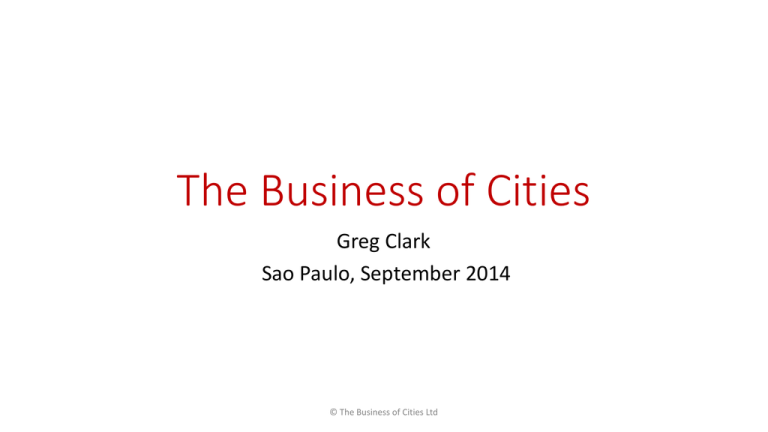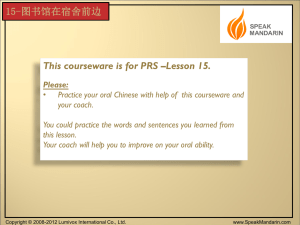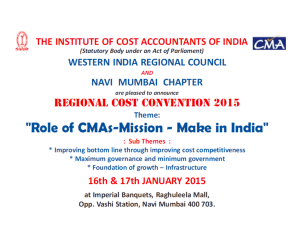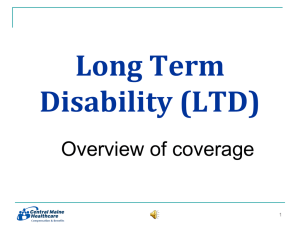The Business of Cities presentation
advertisement

The Business of Cities Greg Clark Sao Paulo, September 2014 © The Business of Cities Ltd The Global Urban Age Much talk of: • The Urban Age • The management of urbanisation. • The global economy. • The global environment. • The ‘rise’ of the ‘city state’. • Smart cities, future cities, and more cities Much less talk of: • The challenges of weak city governance • The urbanisation and re-urbanisation of business © The Business of Cities Ltd Cities and Business – A Rapidly Evolving Relationship Cities and commerce have always been inextricably linked ….. ….. but rapid andcontinuing urbanisation and globalisation are changing the bonds between the two. © The Business of Cities Ltd Part 1 The Changing Dynamics of Business and Cities © The Business of Cities Ltd Trend #1 Cities are Emerging Markets for Businesses © The Business of Cities Ltd Why? • Size of the global metropolitan market • 70% of world population of 9 billion by 2050 • 70 million people per year added to developing world cities • 2 billion strong ‘consumer class’ in emerging market cities by 2025 World’s Urban Population in 2050 Source: UNICEF © The Business of Cities Ltd Why? • Shift in nature of economies and products • Technology is shifting which sectors globalise and how they do so • Growth of service economies encourages commercialisation of urban space • Cities are the natural habitat of innovation (Glaeser, Florida, Hollis, Katz) • Customers of increasing importance • Expansion, upgrading, replacement of infrastructure = €27 trillion over next 25 years (Booz Allen Hamilton) • Smart Cities market = $400 billion by 2020 (UK government) • Building and retrofit – demand for advanced technology and innovations in design, finance, and delivery of city systems • Purchasers of huge range of services from legal advice to landscaping © The Business of Cities Ltd Trend # 2 The rise of Tradeable Urban Services © The Business of Cities Ltd • Growth of Tradable Urban Services • Industries which support city building and growth have become important tradable economic clusters e.g. Planning, architecture, design, energy, water, infrastructure, engineering, waste management, housing development. • Businesses emerged to meet the urbanisation needs of (now) mature cities. • Now, rapidly internationalising to support the growth of emerging cities. Sydney: Engineering and Construction to Dubai and Abu Dhabi London: Architecture and Urban Design Worldwide Paris: Water, Waste and Energy to African cities © The Business of Cities Ltd Masdar City, Foster + Co Masterplan Zaha Hadid deisgn for Abu Dhabi Performing Arts Centre Trend # 3 The growth of ‘city-brands’ by businesses © The Business of Cities Ltd Cities are also key catalysts for businesses • Effective marketing tools • Organising ideas for other offerings E.g. Philips – Liveable Cities brand encompasses lighting, healthcare and renewable energy E.g. Grosvenor Living Cities brand. • Means of fulfilling CSR imperatives E.g. IBM Smarter Cities Challenge - $50m competitive grant programme © The Business of Cities Ltd Grosvenor: Living Cities Corporate Strategy Urbanising Services: City Brands Sustainability / Eco-Cities The ‘City of the Future’ Audi Deutsche Bank Microsoft Atkins GDF Suez Global Cities JP Morgan Aecom AT Kearney Siemens GE Arup Bombardier Smart Cities + Networks Cisco Ericsson IBM Cap Gemini Bird + Bird Liveability Mercer Monocle Grosvenor © The Business of Cities Ltd Urbanising Services • • • • • • Research on urban issues Signature centres of excellence Benchmarking and city indexes Awards and competitions Sponsorship Contributing to dialogue around the future of cities © The Business of Cities Ltd Trend #4 Businesses are (Re)Urbanising © The Business of Cities Ltd Urbanising Locations: Higher Income Nations © The Business of Cities Ltd (Re)Urbanisation – Evidence Australia • 42 major tenants moved from suburban locations to Melbourne CBD between 2008 and 2013 (JLL). UK • 8/10 of Britain’s largest cities have seen private sector jobs become more concentrated in city centres since 2008 (Centre for Cities). • Cities with high proportions of Knowledge Intensive Business Services (KIBS) jobs have experienced particularly strong reurbanisation. • Larger cities tend to have higher proportions of KIBS jobs e.g. London – almost 50% jobs are KIBS. • Examples - Google, Amazon and LinkedIn: acquired major new premises in central London - BUPA, Jacobs (engineering): Business parksof of Cheshire to Manchester © The Business Cities Ltd city centre Distribution of Private Sector jobs in Milton Keynes, 2011 (Centre for Cities) (Re)Urbanisation – Evidence Canada • Commercial vacancy rates decreasing in downtown areas but increasing in suburban areas (Colliers International). • Movement especially noted amongst non-traditional occupiers of core urban space. USA • Since 2011, commercial vacancy rates declined faster in core areas than suburbs (Wall St Journal) • US central city office space rated amongst best prospects for 2014 real estate investment, but suburban office space as worst prospect (JLL) • Venture capital investment now heavily concentrated in core city areas (Richard Florida) • Examples: - United Airlines, Sara Lee: Suburban Illinois to Downtown Chicago - Pinterest, Twitter: Silicon Valley to Downtown San Francisco - Coca Cola: new 2,000 person office© in Downtown Atlanta The Business of Cities Ltd Cities Investment in Urban Core (%) New York, San Diego, Seattle, Austin 80% Boston, LA c.75% Dallas, Washington DC 60% Venture Capital Investment in Urban Core Zip Codes Source: Florida (Re)Urbanisation – Evidence China • In Beijing, core area office vacancy rate declined from 20.7% in 2009 to 4.2% in mid 2013 (Cushman + Wakefield). • Trend is for foreign multinationals entering China to locate HQs in central areas, with back-office business (R&D, logistics and data management) in suburban areas (Cushman + Wakefield). Philippines • Extraordinary office growth in central Manila and other cities fuelled by booming business process outsourcing (BPO) sector. • BPO workers are buying apartments close to work to avoid long commutes in heavy traffic, new work-shop-live complexes have emerged in central urban areas (Oxford Business Group 2012) Japan • Tokyo CBD is expected to see the highest absorption of office spaces in the APAC region in 2014 (Cushman + Wakefield). Major European Cities • In Brussels, Paris, Amsterdam, Madrid, Berlin, Frankfurt, Munich and London cheaper rents in CBD locations during the Global Financial Crisis attracted more occupiers to central areas, pushing up average share of office take-up to 40% in 2010 compared to 33% in 2007 (Savills). © The Business of Cities Ltd Opportunities to collaborate Transport and safety and education Improvements Demographics and lifestyle Technological Advances Why are businesses moving back to the city? Policy-driven and market incentives Sustainability Concerns (eg trade) © The Business of Cities Ltd Changing Working Practices Urbanising Corporate Locations: Emerging World © The Business of Cities Ltd Trend #5 Businesses are restructuring to meet City goals © The Business of Cities Ltd Urbanising Structure: Internal Reorganisation • Cities divisions e.g. Siemens ‘Infrastructure and Cities’ sector • Representatives in target cities e.g. Bank of America ‘Market Presidents’ • Internal city advisory functions e.g. KMPG Cities Global Centre of excellence • City strategies e.g. Air BnB • CRM to manage interactions with cities © The Business of Cities Ltd “Cities are a key growth market for the future. By establishing the Infrastructure & Cities Sector, we’re clearly gearing ourselves to the market. We have the portfolio, the knowhow and the consulting expertise to make cities of all sizes greener and more competitive…..” Roland Busch, Siemens Managing Board, Infrastructure & Cities Sector CEO Case Study – Siemens • Brand = Sustainable Cities • 2011 Infrastructure and Cities (IC) division created. - 16.5 billion Euros annual revenue and 87,000 employees • The ‘Crystal’, Royal Victoria Docks, London - $46million visitor attraction and ‘knowledge hub’ for dialogue, discovery and learning around cities. - World’s largest exhibition focused on urban sustainability - More than 100,000 visitors to date + high profile conferences including G8 Innovation Conference • The Green City Index (with the EIU) - Benchmark assesses and compares environmental performance of more than 120 cities worldwide. • Technical collaboration with C40 Cities Network © The Business of Cities Ltd Case Study - JP Morgan Chase Global Cities Initiative • JPMC fund $10million Brookings Institution initiative • 5 year project (2012 to 2017) aims to help leaders in U.S. metropolitan areas reorient their economies toward greater engagement in world markets • Hosts supporting forums in US and global cities Investing $100m in Detroit (2014-2019) • Largest investment in a city in bank’s history. • Loans and grants will help Detroit to finance housing repairs, blight removal, job training and economic development projects including new M1 rail line. © The Business of Cities Ltd “We need to put capital and knowledge to work in partnership with local governments and businesses so that cities can invest in the kind of 21st century infrastructure and export capabilities they need to compete and win in today’s global economy.” Jamie Dimon, CEO JP Morgan Chase Case Study - JLL • JLL Cities Research Centre - Original research, blogs and toolkits on cities. Includes a proprietary database of KPIs covering more than 650 cities worldwide. Compiles benchmarks e.g. City Momentum Index, Global Office Index, Real Estate Transparency Index, Global Capital Flows. • JLL Africa Cities Research Programme - Launched 2013 Focuses on 40 largest African cities • Carbon Disclosure Project - Cities programme - JLL is lead sponsor Seeks to improve climate change information disclosed at city level. © The Business of Cities Ltd Case Study – Buro Happold • ‘Living Cities’ brand - markets an integrated approach to urban development • Brand combines the firm’s offerings in: city diagnostics & strategy; environment & resource management; infrastructure; masterplanning; programme delivery. • Buro Happold engineering division split into two internal departments: ‘Buildings’ and ‘Cities’ • Firm is masterplanning several cities: Kama Tri City in Russia, Sabah Al Ahmad Sea City in Kuwait and Gia Lam in Vietnam. © The Business of Cities Ltd Buro Happold – Living Cities model Case Study - Philips Brand = Livable Cities • In house think tank which aims to “aid the transformation of a city in its own unique setting through the lenses of 'authenticity, inclusion and resilience’’. • Books and Reports e.g. Create the Livable City; Cities and Ageing • Twitterfeed, Blogs, Pinterest boards • Hosts conferences e.g. Create the Livable City– Glasgow 2013 • Sponsors debates e.g. EIU debate on city sprawl • Livable Cities Award – aims to generate innovative, meaningful and achievable ideas to improve the health and well-being of city-dwellers © The Business of Cities Ltd Case Study – Air BnB Following tensions with city authorities, AirBnB has: • Published studies to demonstrate its positive impact in 9 cities. • Launched ‘Shared City’ programme - Aims to “help civic leaders … create more shareable, more livable cities through relevant, concrete actions and partnerships.” - Helps local governments collect hospitality taxes from users; - Hosts can donate a percentage of their fee to a local cause + AirBnB matches the donation; - In Portland, working with the tourism bureau on joint campaigns to promote the city and its small businesses • Main sponsor of Jane’s Walks NYC, a festival of guided walks celebrating the© The legacy of Jane Jacobs. Business of Cities Ltd More than 100 companies now have city branded services and products © The Business of Cities Ltd Trend #6 Cities are Hubs of Business Innovation © The Business of Cities Ltd Cities as Test Markets • The most cosmopolitan cities are microcosms of the global market – ideal locations for developing / trialling products • Some cities promote their role as regional test markets - Invest in Brussels: city representative of the European Market - Jakarta – densely populated, high consumer confidence, testing ground for emerging markets • Others have become renowned as national test markets - Columbus, Ohio – US fast food - Bangalore – product testing for Indian market • Diverse labour forces develop content which translates © The Business of Cities Ltd across cultural barriers Business- City Innovation Partnerships • Collaboration to develop products to tackle specific city challenges • IBM & Rio de Janeiro – City wide operation centre, prototype for disaster management product • Microsoft & Barcelona – Cloud based platform to collect and share city data • Arup & Manila – solutions for flood management • Veolia & Lyon – pool skills and expertise to develop new sustainable city concepts • Living Labs • • Experiments run in situ to increase understanding of urban environments and develop new products Usually collaborations between city governments, academic institutions and business © The Business of Cities Ltd e.g. London (Intel); Smart City Malaga (Endesa). Part 2 The New Roles of Business in City Development © The Business of Cities Ltd Role #1 Business and City Partnerships an Joint Ventures © The Business of Cities Ltd Business and City Partnerships • Collaboration in Development of New Cities - Songdo & Cisco – supplies all network technologies - Tianjin Eco-City: Panasonic, GM, Philips, Sky are partners - Smaller companies too: RLG Communications financing 30% Hope City, Ghana • Joining Forces to Enhance Exports and Foreign Investment e.g. Portland’s Metro Export Initiative - companies in the city’s clean tech, tourism and education sectors are collaborating with local government in a “We Build Green cities” branding campaign • Financial Support for City Development - Philanthropic: e.g. IBM Smarter Cities’ Challenge - Business led e.g. Siemens part financed London’s Thameslink; JP Morgan investing in new Detroit ©M1 rail line The Business of Cities Ltd Role #2 Cities use Business Management Approaches and Tools © The Business of Cities Ltd Benchmarking, Rankings and Indices Produced by commercial outlets, but increasingly used by cities themselves: Pedagogy Comparative pegging Diagnostic assessment Leverage and persuasion Urban performance management through indexes © The Business of Cities Ltd Home truths © The Business of Cities Ltd Strategic Planning – Business Planning for Cities • Adopted from business – influenced by models such as Porter’s Five Forces, Barney’s VRIN model, the balanced scorecard. Increasingly popular in cities + metros. • Advantages • • • • • Prioritisation and Target Setting Plan for land use, transport and infrastructure investments over the medium to long term. Breed continuity of strategic direction beyond individual electoral cycles Aid prudent budgeting and fiscal management Address preparedness for population growth, environmental and technological change. © The Business of Cities Ltd City Branding • Competitive cities. • Customer orientation - business friendly, open for talent, investment ready • More than logos or strap lines, city brands communicate a ‘whole story’ about the value the city can offer to mobile activities. • Developed from corporate branding • BUT differences lurk: no overarching management body responsible for a city. • Creating a coherent brand out of disparate images, groups and spaces = key challenge in city branding. © The Business of Cities Ltd Cities + Investment Investment rate matters to cities as well as businesses - they also compete and face risks and costs, investment rate is part of productivity and competitiveness and sustainability for cities. Investment Rate or Investment Gap Deficit Balance Sheet and Portfolio Management How does Investment Rate matter to cities? • • • • • • Operating platform for business/ Liveability platform for people. Speed of adjustment of urban fabric and infrastructure. Systems integration and smartness. Business climate and incentive structure. Value creation and capture. Visibility of investment deficits and impact on reputation and confidence. Internal Rate of Return External Rate of Return © The Business of Cities Ltd Role #3 Business and City Governance © The Business of Cities Ltd Beyond privatisation and PPPs © The Business of Cities Ltd Business Leadership Groups • Overcome constraints which bind city authorities: • Think beyond short term electoral cycles • Look beyond political geography / electoral boundaries • Members have experience in branding, sales, marketing, agenda setting, prioritizing • Strong bargaining position with central government as ‘customers’ rather than subordinates. • Develop strategies and advocate for policies to enhance a city’s competitiveness. • Often work collaboratively with local government and other city stakeholders • More dynamic and proactive than traditional Chambers of Commerce. • Concerned with making contributions to urban and metropolitan development. © The Business of Cities Ltd Business Involvement in City Networks • Businesses are joining, funding or working in collaboration with city-networks. • Influential means of shaping policy • Building relationships with city authorities and other stakeholders • Fulfilling CSR imperatives. • Examples: • C40 Climate Leadership Group – Arup & Siemens’ collaborations • City Protocol – Network of cities, academic institutions and businesses • WBCSD’s Urban Infrastructure Initiative (UII) - experts from 14 leading global companies, join together to help 10 cities around the world identify and develop sustainability solutions © The Business of Cities Ltd Part 3 Are Cities Like Businesses? © The Business of Cities Ltd Are Cities Like Businesses? • • • • • • • Compete in contested markets Innovative use of financial resources Clearly defined goals Networking R & D, Innovation and Investment Human Capital Brand • Leadership © The Business of Cities Ltd Are Cities Like Businesses? • Risk taking is controlled • Poor fit between institutional and market geography • Complex governance arrangements • Cannot choose ‘customers’ • Cannot choose products and services • Citizens have wider range of interests than customers • ‘Profit’ is retained by other tiers of Gov • City leaders: • democratically elected and accountable • may have limited power. • Identity and brand shaped by others • Do not ‘fail’ to the point of extinction © The Business of Cities Ltd Concluding Thoughts Business and the Future of Cities © The Business of Cities Ltd Business and the Future of Cities Cities must look to take advantage of their new relationship with businesses in order to secure their best possible futures. They can do this by: • Being business friendly and Investment Ready • Drawing inspiration and lessons from the private sector, and borrowing techniques and tools. • Collaborating with business for hugely beneficial outcomes, particularly through innovation partnerships. • Seeking support from the corporate world to negotiate desired future outcomes with higher tiers of government and global economy. • Welcoming diverse and international populations. Open Cities are innovative. • Remaining mindful of their distinctiveness from business, and the separate but complementary roles that each have to play. © The Business of Cities Ltd







